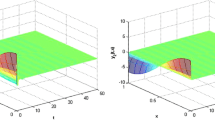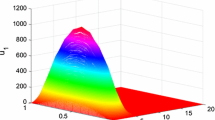Abstract
The asymptotic stability of delayed reaction-diffusion neural networks with algebraic constraints, that is, singular delayed reaction-diffusion neural networks, is studied in this paper. In terms of Green’s theorem, inequality technique and linear matrix inequalities (LMIs), two less conservative criterion for the asymptotic stability of singular delayed reaction-diffusion neural networks are given by endowing Lyapunov direct method and used to design an appropriate stabilizing feedback controllers. The results address both the effects of the delay and the algebraic constraints. In addition, these conditions have higher computational efficiency and can easily detect and stabilize the actual neural networks. Finally, the numerical simulations verify the validity of the theoretical analysis.





Similar content being viewed by others
References
Le W, Xu Z, Kun W, Xiang C, Xun C (2020) Improved high-density myoelectric pattern recognition control against electrode shift using data augmentation and dilated convolutional neural network. IEEE Trans Neural Syst Rehabilit Eng. https://doi.org/10.1109/TNSRE.2020.3030931
Efe MO, Kaynak O (2000) Stabilizing and robustifying the learning mechanisms of artificial neural networks in control engineering applications. Int J Intell Syst 15:365–388
Aouiti C, Assali E (2019) Nonlinear Lipschitz measure and adaptive control for stability and synchronization in delayed inertial Cohen-Grossberg-type neural networks. Int J Adapt Control Signal Process 33:1457–1477
Aouiti C, Assali E (2019) Stability analysis for a class of impulsive high-order Hopfield neural networks with leakage time-varying delays. Neural Comput Appl 31:7781–7803
Aouiti C, Assali E (2019) Stability analysis for a class of impulsive bidirectional associative memory (BAM) neural networks with distributed delays and leakage time-varying delays. Neural Process Lett 50:851–885
Sedighi R, Meiabadi M, Sedighi M (2017) Optimisation of gate location based on weld line in plastic injection moulding using computeraided engineering, artificial neural network, and genetic algorithm, International Journal of Automotive and Mechanical. Engineering 14:4419–4431
Ahmed I, Iqbal MJ, Basheri M (2020) Biological data classification and analysis using convolutional neural network. J Med Imaging Health Inf 10:2459–2465
Gunther J, Reichensdorfer E, Pilarski PM, Diepold K (2020) Interpretable PID parameter tuning for control engineering using general dynamic neural networks: An extensive comparison, PLoS ONE, 15, Article ID: e0243320
Fernandez-Blanco E, Rivero D, Pazos A (2020) EEG signal processing with separable convolutional neural network for automatic scoring of sleeping stage. Neurocomputing 410:220–228
Spoerer CJ, Kietzmann TC, Mehrer J, Charest I, Kriegeskorte N (2020) Recurrent neural networks can explain flexible trading of speed and accuracy in biological vision, PLoS Comput Biol, 16, Article ID: e1008215
Liu XZ, Li ZT, Wu KN (2020) Boundary Mittag-Leffler stabilization of fractional reaction-diffusion cellular neural networks. Neural Netw 132:269–280
Liu XZ, Wu KN, Zhang WH (2020) Intermittent boundary stabilization of stochastic reaction-diffusion Cohen-Grossberg neural networks. Neural Netw 131:1–13
Wang LM, He HB, Zeng ZG, Hu C (2020) Global stabilization of fuzzy memristor-based reaction-diffusion neural networks. IEEE Trans Cybern 50:4658–4669
Aouiti C, Jallouli H (2021) State feedback controllers based finite-time and fixed-time stabilisation of high order BAM with reaction-diffusion term. Int J Syst Sci 52:905–927
Wu T, Cao JD, Xiong LL, Xie XQ (2020) New results on stability analysis and extended dissipative conditions for uncertain memristive neural networks with two additive time-varying delay components and reaction-diffusion terms. Int J Robust Nonlinear Control 30:6535–6568
Sheng Y, Zhang H, Zeng ZG (2020) Stability and robust stability of stochastic reaction-diffusion neural networks with infinite discrete and distributed delays. IEEE Trans Syst Man Cybern Syst 50:1721–1732
Wei TD, Lin P, Wang YF, Wang LS (2019) Stability of stochastic impulsive reaction-diffusion neural networks with S-type distributed delays and its application to image encryption. Neural Netw 116:35–45
Hou J, Huang YL, Yang EF (2019) \(\Psi\)-type stability of reaction-diffusion neural networks with time-varying discrete delays and bounded distributed delays. Neurocomputing 340:281–293
Lv TS, Gan QT, Xiao F (2019) Stability for a class of generalized reaction-diffusion uncertain stochastic neural networks with mixed delays. Int J Mach Learn Cybern 10:967–978
Rao RF, Zhong SM, Pu ZL (2019) Fixed point and p-stability of T-S fuzzy impulsive reaction-diffusion dynamic neural networks with distributed delay via Laplacian semigroup. Neurocomputing 335:170–184
Yang ZC, Zhou WS, Huang TW (2019) Input-to-state stability of delayed reaction-diffusion neural networks with impulsive effects. Neurocomputing 333:261–272
Edwards D (2002) Process safety and environmental protection - Editorial - SH&E performance - Objective(s) or constraints? Process Saf Environ Prot 80:287–288
Ferris JM (2015) Procurement costs and tool performance requirements: determining constraints on lithic toolstone selection in baja california sur
Studli S, Corless M, Middleton RH, Shorten R (2017) On the AIMD algorithm under saturation constraints. IEEE Trans Autom Control 62:6392–6398
Martinez CA, Wang CJ (2015) Structural constraints on learning in the neural network. J Neurophysiol 114:2555–2557
Maggini M, Melacci S, Sarti L (2012) Learning from pairwise constraints by similarity neural networks. Neural Netw 26:141–158
Xiong WJ, Yu XH, Patel R, Huang TW (2018) Stability of singular discrete-time neural networks with state-dependent coefficients and run-to-run control strategies. IEEE Trans Neural Netw Learn Syst 12:6415–6420
Zhang YQ, Shi P, Agarwal RK, Shi Y (2020) Event-based dissipative analysis for discrete time-delay singular jump neural networks. IEEE Trans Neural Netw Learn Syst 31:1232–1241
Ma YC, Ma NN, Chen L, Zheng YQ, Han Y (2019) Exponential stability for the neutral-type singular neural network with time-varying delays. Int J Mach Learn Cybern 10:853–858
Liu S, Zhou XF, Li X, Jiang W (2016) Stability of fractional nonlinear singular systems and its applications in synchronization of complex dynamical networks. Nonlinear Dyn 84:2377–2385
Liu S, Li X, Zhou XF, Jiang W (2015) Synchronization analysis of singular dynamical networks with unbounded time-delays. Adv Differ Equ 193:1–9
Wu H, Zhang X, Li R, Yao R (2015) Synchronization of reaction-diffusion neural networks with mixed time-varying delays. J Control Autom Electrical Syst 26:16–27
Chen LP, Huang TW, Machado JA, Lopes AM, Chai Y, Wu RC (2019) Delay-dependent criterion for asymptotic stability of a class of fractional-order memristive neural networks with time-varying delays. Neural Netw 118:289–299
Ma YC, Zheng YQ (2018) Delay-dependent stochastic stability for discrete singular neural networks with Markovian jump and mixed time-delays. Neural Comput Appl 29:111–122
Zhang H, Sheng Y, Zeng Z (2018) Synchronization of coupled reaction-diffusion neural networks with directed topology via an adaptive approach. IEEE Trans Neural Netw Learn Syst 29:1550–1561
Lu GP, Ho DWC (2006) Generalized quadratic stability for continuous-time singular systems with nonlinear perturbation. IEEE Trans Autom Control 51:818–823
Gilbarg D, Trudinger NS (1991) Elliptic partial differential equations of second order. Springer, Berklin
Li RX, Cao JD (2016) Stability analysis of reaction-diffusion uncertain memristive neural networks with time-varying delays and leakage term. Appl Math Comput 278:54–69
Zhang RM, Zeng DQ, Park JH, Liu YJ, Xie XP (2020) Adaptive event-triggered synchronization of reaction-diffusion neural networks. IEEE Trans Neural Netw Learn Syst. https://doi.org/10.1109/TNNLS.2020.3027284
Song XN, Man JT, Song S, Ahn CK (2020) Gain-scheduled finite-time synchronization for reaction-diffusion memristive neural networks subject to inconsistent markov chains. IEEE Trans Neural Netw Learn Syst. https://doi.org/10.1109/TNNLS.2020.3009081
Liu PC, Cao GY (2020) Employing the Friedrichs inequality to ensure global exponential stability of delayed reaction-diffusion neural networks with nonlinear boundary conditions. Neurocomputing 383:81–94
Acknowledgements
This research is supported by the National Natural Science Foundation of China (Nos. U1806203 and 61533011).
Author information
Authors and Affiliations
Corresponding author
Ethics declarations
Conflict of Interest
We declare that we have no financial and personal relationships with other people or organizations that can inappropriately influence our work, there is no professional or other personal interest of any nature or kind in any product, service and/or company that could be constructed as influencing the position presented in, or the review of, the manuscript entitled.
Additional information
Publisher's Note
Springer Nature remains neutral with regard to jurisdictional claims in published maps and institutional affiliations.
Rights and permissions
About this article
Cite this article
Wu, X., Liu, S., Wang, Y. et al. Asymptotic stability of singular delayed reaction-diffusion neural networks. Neural Comput & Applic 34, 8587–8595 (2022). https://doi.org/10.1007/s00521-021-06740-x
Received:
Accepted:
Published:
Issue Date:
DOI: https://doi.org/10.1007/s00521-021-06740-x




